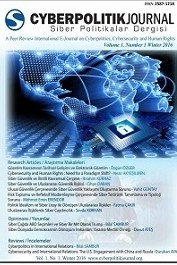CYBERSECURITY IN EDUCATIONAL SETTINGS
Siber güvenlik, siber tehditler, eğitim ortamları
CYBERSECURITY IN EDUCATIONAL SETTINGS
Cyber security, cyber threats, educational settings,
___
- Bardas, A. G. and Ou, X. (2013). Setting up and using a cyber security lab for education purposes. Retrieved December 30, 2017, from http://people.cs.ksu.edu/~bardasag/publications/cdc2013.pdf
- Bıçakcı, S. (2014). Nato’nun gelişen tehdit algısı: 21. yüzyılda siber güvenlik. Uluslararası İlişkiler, 10(40), 101-130.
- Bıçakcı, S., Ergun, D., Çelikpala, M. (2015). Türkiye’de siber güvenlik. Ekonomi ve Dış Politika Araştırmalar Merkezi. Technical report.
- BTK (2009). Siber güvenliğin sağlanması: Türkiye’deki mevcut durum ve alınması gereken tedbirler. Bilgi teknolojileri ve iletişim kurumu raporu.
- Çetin, H., Gundak, İ. and Çetin H. H. (2015). E-işletme güvenliği ve siber saldırılar üzerine bir araştırma. Çankırı Karatekin University Journal of Institute of Social Sciences, 6(2, 223-240.
- Erol, O., Şahin, Y. L., Yılmaz, E. and Haseski, H. İ. (2015). Personal cyber security provision scale development study. International Journal of Human Sciences, 12(2), 75-91.
- Fischer, E. A. (2016). Cybersecurity issues and challenges: in brief. Congressional Research Service Report.
- Hansen, L. and Nissenbaum, H. (2009). Digital disaster, cyber security, and the Copenhagen school. International Studies Quarterly, 53, 1155-1175.
- IIROC (2015). Cybersecurity best practices guide for IIROC dealer members. Technical report.
- Kara, M. (2013). Siber saldırılar – siber savaşlar ve etkileri. (Unpublished master’s thesis). İstanbul Bilgi University, İstanbul.
- KPMG (2014). Cyber security: it is not just about technology. The five most common mistakes. Report. Sweden.
- New York State Office of Homeland Security and New York State Board of Education (2004). Best practices for school safety and security.
- Öğün, M. N. and Kaya, A. (2013). Siber güvenliğin milli güvenlik açısından önemi ve alınabilecek tedbirler. Security Strategies, 9(18), 145-181.
- Payne, S. (2003). Developing security education and awareness programs. Educause Quarterly, 4, 49-53.
- Saluja, S., Bansal, D. and Saluja, S. (2012). Cyber safety education in high schools. International Conference on Computer Technology and Science, 47, 107-112.
- The Government of the HKSAR (2007). Information technology in education project, IT security in schools. Education Infrastructure Division Education Bureau.
- Tikk, E. (2011). Ten rules for cyber security. Survival, 53(3), 119-132.
- Universities UK (2013). Cyber security and universities: managing the risk. Retrieved December 31, 2017, from http://www.universitiesuk.ac.uk/policy-andanalysis/reports/Documents/2013/cyber-security-and-universities.pdf
- Yılmaz, S. and Sağıroğlu, Ş. (2013). Siber güvenlik risk analizi, tehdit ve hazırlık seviyeleri. Paper presented at the 6th International Information Security and Cryptology Conference. Ankara, Turkey.
- ISSN: 2587-1218
- Başlangıç: 2017
- Yayıncı: Cyberpolitik Journal
CYBERSECURITY IN EDUCATIONAL SETTINGS
The New Face of the War: Cyber Warfare
Mehmet Emin Erendor, Gürkan TAMER
DEEP WEB VE DARK WEB: İNTERNET’İN DERİN DÜNYASI
SİBER UZAYDA AKTÖR - GÜÇ İLİŞKİSİ
SİBER UZAY VE ULUSLAR ARASI İLİŞKİLER / TEORİSİ
STAYING AHEAD IN THE CYBER SECURITY GAME: WHAT MATTERS NOW
KÜRESELLEŞME SÜRECİNDE DÖNÜŞEN GÜVENLİK ALGISI VE SİBER GÜVENLİK
